二、PyTorch 入门实战—Variable(转)
一、概念
1.Numpy里没有Variable这个概念,如果大家学过TensorFlow就会知道,Variable提供了自动求导的功能。
2.Variable需要放进一个计算图中,然后进行前后向传播和自动求导。
3.Variable的属性有三个:
- data:Variable里Tensor变量的数值
- grad:Variable反向传播的梯度
- grad_fn:得到Variable的操作
二、Variable的创建和使用
1.我们首先创建一个空的Variable:
import torch
#创建Variable
a = torch.autograd.Variable()
print(a)
结果如下:

可以看到默认的类型为Tensor
2.那么,我们如果需要给Variable变量赋值,那么就一定是Tensor类型,例如:
b = torch.autograd.Variable(torch.Tensor([[1, 2], [3, 4],[5, 6], [7, 8]]))
print(b)
代码变为:
import torch
#创建Variable
a = torch.autograd.Variable()
print(a)
b = torch.autograd.Variable(torch.Tensor([[1, 2], [3, 4],[5, 6], [7, 8]]))
print(b)
结果为:

3.第一章提到了Variable的三个属性,我们依次打印它们:
import torch
#创建Variable
a = torch.autograd.Variable()
print(a)
b = torch.autograd.Variable(torch.Tensor([[1, 2], [3, 4],[5, 6], [7, 8]]))
print(b)
print(b.data)
print(b.grad)
print(b.grad_fn)
结果为:
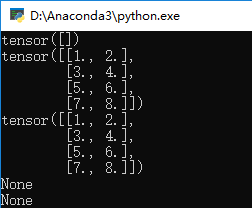
可以看到data就是Tensor的内容,剩下的两个属性为空
三、标量求导计算图
1.为了方便起见,我们可以将torch.autograd.Variable简写为Variable:
from torch.autograd import Variable
2.之后,我们先声明一个变量x,这里requires_grad=True意义是否对这个变量求梯度,默认的 Fa!se:
x = Variable(torch.Tensor([2]),requires_grad = True)
print(x)
代码变为:
import torch
#创建Variable
a = torch.autograd.Variable()
print(a)
b = torch.autograd.Variable(torch.Tensor([[1, 2], [3, 4],[5, 6], [7, 8]]))
print(b)
print(b.data)
print(b.grad)
print(b.grad_fn) #建立计算图
from torch.autograd import Variable
x = Variable(torch.Tensor([2]),requires_grad = True)
print(x)
结果为:
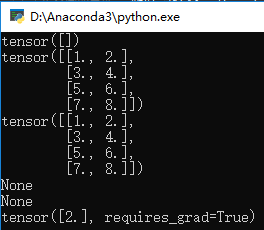
3.我们再声明两个变量w和b:
w = Variable(torch.Tensor([3]),requires_grad = True)
print(w)
b = Variable(torch.Tensor([4]),requires_grad = True)
print(b)
4.我们再写两个变量y1和y2:
y1 = w * x + b
print(y1)
y2 = w * x + b * x
print(y2)
5.我们来计算各个变量的梯度,首先是y1:
#计算梯度
y1.backward()
print(x.grad)
print(w.grad)
print(b.grad)
代码变为:
import torch
#创建Variable
a = torch.autograd.Variable()
print(a)
b = torch.autograd.Variable(torch.Tensor([[1, 2], [3, 4],[5, 6], [7, 8]]))
print(b)
print(b.data)
print(b.grad)
print(b.grad_fn) #建立计算图
from torch.autograd import Variable
x = Variable(torch.Tensor([2]),requires_grad = True)
print(x)
w = Variable(torch.Tensor([3]),requires_grad = True)
print(w)
b = Variable(torch.Tensor([4]),requires_grad = True)
print(b)
y1 = w * x + b
print(y1)
y2 = w * x + b * x
print(y2)
#计算梯度
y1.backward()
print(x.grad)
print(w.grad)
print(b.grad)
结果为:

其中:
y1 = 3 * 2 + 4 = 10,
y2 = 3 * 2 + 4 * 2 = 14,
x的梯度是3因为是3 * x,
w的梯度是2因为w * 2,
b的梯度是1因为b * 1(* 1被省略)
6.其次是y2,注销y1部分:
y2.backward(x)
print(x.grad)
print(w.grad)
print(b.grad)
代码为: import torch
#创建Variable
a = torch.autograd.Variable()
print(a)
b = torch.autograd.Variable(torch.Tensor([[1, 2], [3, 4],[5, 6], [7, 8]]))
print(b)
print(b.data)
print(b.grad)
print(b.grad_fn) #建立计算图
from torch.autograd import Variable
x = Variable(torch.Tensor([2]),requires_grad = True)
print(x)
w = Variable(torch.Tensor([3]),requires_grad = True)
print(w)
b = Variable(torch.Tensor([4]),requires_grad = True)
print(b)
y1 = w * x + b
print(y1)
y2 = w * x + b * x
print(y2)
#计算梯度
#y1.backward()
#print(x.grad)
#print(w.grad)
#print(b.grad)
y2.backward()
print(x.grad)
print(w.grad)
print(b.grad)
结果为:
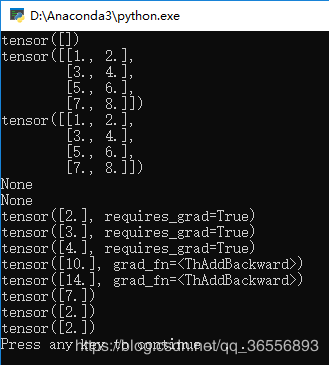
其中:
x的梯度是7因为是3 * x + 4 * x,
w的梯度是2因为w * 2,
b的梯度是2因为b * 2
7.backward的函数可以填入参数,例如我们填入变量a:
a = Variable(torch.Tensor([5]),requires_grad = True)
y2.backward(a)
print(x.grad)
print(w.grad)
print(b.grad)
代码变为:
import torch
#创建Variable
a = torch.autograd.Variable()
print(a)
b = torch.autograd.Variable(torch.Tensor([[1, 2], [3, 4],[5, 6], [7, 8]]))
print(b)
print(b.data)
print(b.grad)
print(b.grad_fn) #建立计算图
from torch.autograd import Variable
x = Variable(torch.Tensor([2]),requires_grad = True)
print(x)
w = Variable(torch.Tensor([3]),requires_grad = True)
print(w)
b = Variable(torch.Tensor([4]),requires_grad = True)
print(b)
y1 = w * x + b
print(y1)
y2 = w * x + b * x
print(y2)
#计算梯度
#y1.backward()
#print(x.grad)
#print(w.grad)
#print(b.grad)
a = Variable(torch.Tensor([5]),requires_grad = True)
y2.backward(a)
print(x.grad)
print(w.grad)
print(b.grad)
结果为:
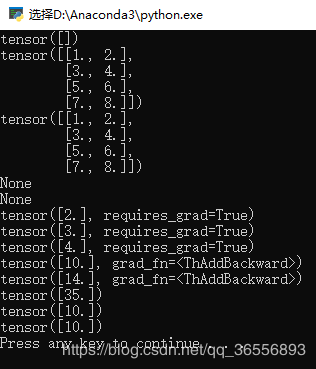
可以看到x,w,b的梯度乘以了a的值5,说明这个填入参数是梯度的系数。
四、矩阵求导计算图
1.例如:
#矩阵求导
c = torch.randn(3)
print(c)
c = Variable(c,requires_grad = True)
print(c)
y3 = c * 2
print(y3)
y3.backward(torch.FloatTensor([1, 0.1, 0.01]))
print(c.grad)
代码变为:
import torch
#创建Variable
a = torch.autograd.Variable()
print(a)
b = torch.autograd.Variable(torch.Tensor([[1, 2], [3, 4],[5, 6], [7, 8]]))
print(b)
print(b.data)
print(b.grad)
print(b.grad_fn) #建立计算图
from torch.autograd import Variable
x = Variable(torch.Tensor([2]),requires_grad = True)
print(x)
w = Variable(torch.Tensor([3]),requires_grad = True)
print(w)
b = Variable(torch.Tensor([4]),requires_grad = True)
print(b)
y1 = w * x + b
print(y1)
y2 = w * x + b * x
print(y2)
#计算梯度
#y1.backward()
#print(x.grad)
#print(w.grad)
#print(b.grad)
a = Variable(torch.Tensor([5]),requires_grad = True)
y2.backward(a)
print(x.grad)
print(w.grad)
print(b.grad) #矩阵求导
c = torch.randn(3)
print(c)
c = Variable(c,requires_grad = True)
print(c)
y3 = c * 2
print(y3)
y3.backward(torch.FloatTensor([1, 0.1, 0.01]))
print(c.grad)
结果为:
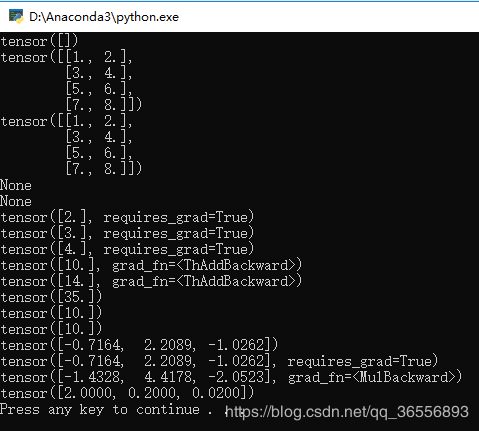
可以看到,c是一个1行3列的矩阵,因为y3 = c * 2,因此如果backward()里的参数为:
torch.FloatTensor([1, 1, 1])
则就是每个分量的梯度,但是传入的是:
torch.FloatTensor([1, 0.1, 0.01])
则每个分量梯度要分别乘以1,0.1和0.01
五、Variable放到GPU上执行
1.和Tensor一样的道理,代码如下:
#Variable放在GPU上
if torch.cuda.is_available():
d = c.cuda()
print(d)
代码变为:
import torch
#创建Variable
a = torch.autograd.Variable()
print(a)
b = torch.autograd.Variable(torch.Tensor([[1, 2], [3, 4],[5, 6], [7, 8]]))
print(b)
print(b.data)
print(b.grad)
print(b.grad_fn) #建立计算图
from torch.autograd import Variable
x = Variable(torch.Tensor([2]),requires_grad = True)
print(x)
w = Variable(torch.Tensor([3]),requires_grad = True)
print(w)
b = Variable(torch.Tensor([4]),requires_grad = True)
print(b)
y1 = w * x + b
print(y1)
y2 = w * x + b * x
print(y2)
#计算梯度
#y1.backward()
#print(x.grad)
#print(w.grad)
#print(b.grad)
a = Variable(torch.Tensor([5]),requires_grad = True)
y2.backward(a)
print(x.grad)
print(w.grad)
print(b.grad) #矩阵求导
c = torch.randn(3)
print(c)
c = Variable(c,requires_grad = True)
print(c)
y3 = c * 2
print(y3)
y3.backward(torch.FloatTensor([1, 0.1, 0.01]))
print(c.grad)
#Variable放在GPU上
if torch.cuda.is_available():
d = c.cuda()
print(d)
2.生成结果会慢一下,然后可以看到多了一个device=‘cuda:0’和grad_fn=<CopyBackwards>
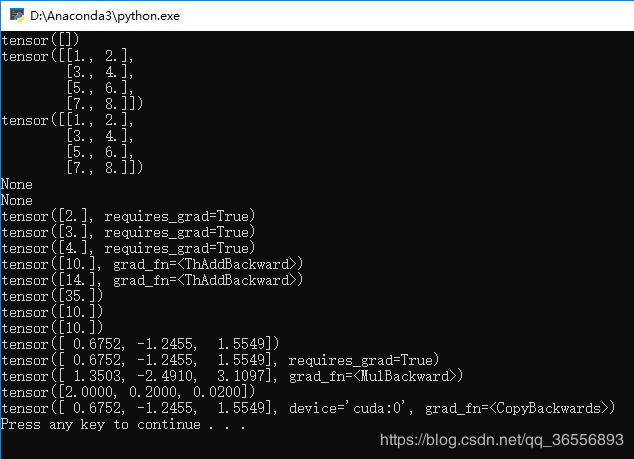
六、Variable转Numpy与Numpy转Variable
1.值得注意的是,Variable里requires_grad 一般设置为 False,代码中为True则:
#变量转Numpy
e = Variable(torch.Tensor([4]),requires_grad = True)
f = e.numpy()
print(f)
会报如下错误:
Can't call numpy() on Variable that requires grad. Use var.detach().numpy() instead.
2.解决方法1:requires_grad改为False后,可以看到最后一行的Numpy类型的矩阵[4.]:
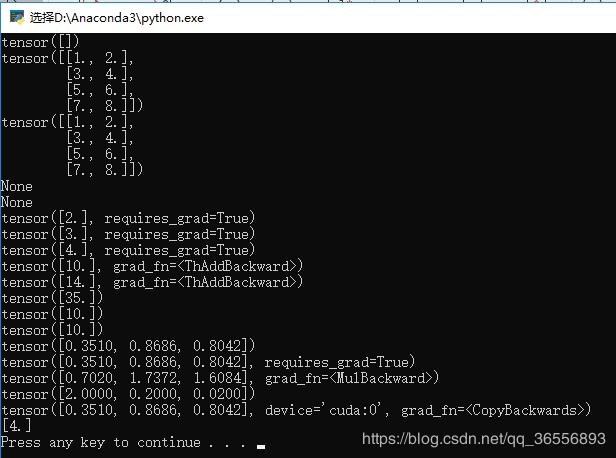
3.解决方法2::将numpy()改为detach().numpy(),可以看到最后一行的Numpy类型的矩阵[4.]
#变量转Numpy
e = Variable(torch.Tensor([4]),requires_grad = True)
f = e.detach().numpy()
print(f)
代码变为:
import torch
#创建Variable
a = torch.autograd.Variable()
print(a)
b = torch.autograd.Variable(torch.Tensor([[1, 2], [3, 4],[5, 6], [7, 8]]))
print(b)
print(b.data)
print(b.grad)
print(b.grad_fn) #建立计算图
from torch.autograd import Variable
x = Variable(torch.Tensor([2]),requires_grad = True)
print(x)
w = Variable(torch.Tensor([3]),requires_grad = True)
print(w)
b = Variable(torch.Tensor([4]),requires_grad = True)
print(b)
y1 = w * x + b
print(y1)
y2 = w * x + b * x
print(y2)
#计算梯度
#y1.backward()
#print(x.grad)
#print(w.grad)
#print(b.grad)
a = Variable(torch.Tensor([5]),requires_grad = True)
y2.backward(a)
print(x.grad)
print(w.grad)
print(b.grad) #矩阵求导
c = torch.randn(3)
print(c)
c = Variable(c,requires_grad = True)
print(c)
y3 = c * 2
print(y3)
y3.backward(torch.FloatTensor([1, 0.1, 0.01]))
print(c.grad)
#Variable放在GPU上
if torch.cuda.is_available():
d = c.cuda()
print(d)
#变量转Numpy
e = Variable(torch.Tensor([4]),requires_grad = True)
f = e.detach().numpy()
print(f)
结果为:
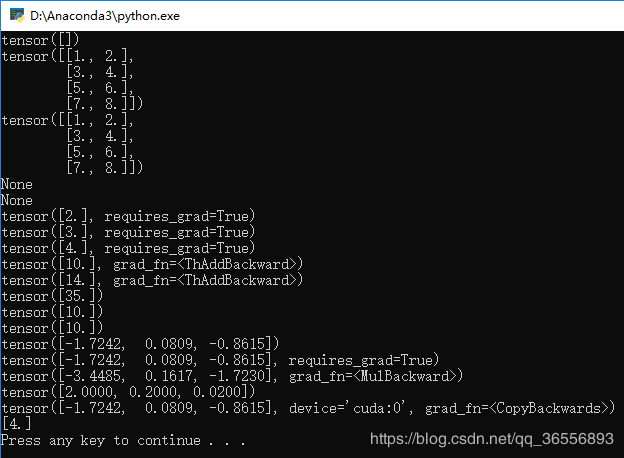
4.Numpy转Variable先是转为Tensor再转为Variable:
#转换为Tensor
g = torch.from_numpy(f)
print(g)
#转换为Variable
g = Variable(g,requires_grad = True)
print(g)
代码变为:
import torch
#创建Variable
a = torch.autograd.Variable()
print(a)
b = torch.autograd.Variable(torch.Tensor([[1, 2], [3, 4],[5, 6], [7, 8]]))
print(b)
print(b.data)
print(b.grad)
print(b.grad_fn) #建立计算图
from torch.autograd import Variable
x = Variable(torch.Tensor([2]),requires_grad = True)
print(x)
w = Variable(torch.Tensor([3]),requires_grad = True)
print(w)
b = Variable(torch.Tensor([4]),requires_grad = True)
print(b)
y1 = w * x + b
print(y1)
y2 = w * x + b * x
print(y2)
#计算梯度
#y1.backward()
#print(x.grad)
#print(w.grad)
#print(b.grad)
a = Variable(torch.Tensor([5]),requires_grad = True)
y2.backward(a)
print(x.grad)
print(w.grad)
print(b.grad) #矩阵求导
c = torch.randn(3)
print(c)
c = Variable(c,requires_grad = True)
print(c)
y3 = c * 2
print(y3)
y3.backward(torch.FloatTensor([1, 0.1, 0.01]))
print(c.grad)
#Variable放在GPU上
if torch.cuda.is_available():
d = c.cuda()
print(d)
#变量转Numpy
e = Variable(torch.Tensor([4]),requires_grad = True)
f = e.detach().numpy()
print(f)
#转换为Tensor
g = torch.from_numpy(f)
print(g)
#转换为Variable
g = Variable(g,requires_grad = True)
print(g)
结果为:
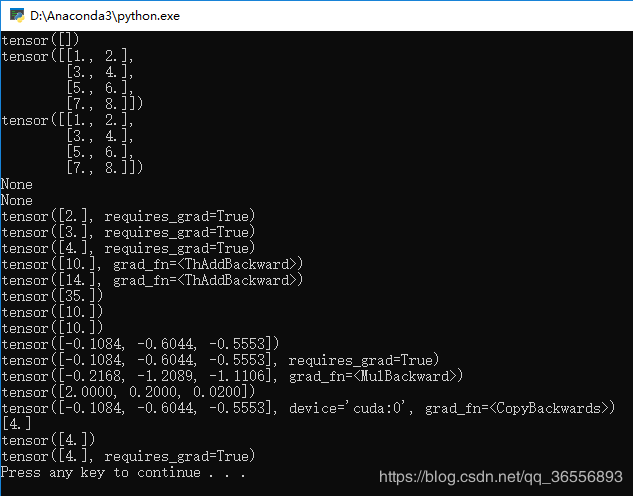
七、Variable总结
1.Variable和Tensor本质上没有区别,不过Variable会被放入一个计算图中,然后进行前向传播,反向传播,自动求导。
2.Variable有三个属性,可以通过构造函数结构求取梯度得到grad值和grad_fn值
3.Variable,Tensor和Numpy互相转化很方便,类型也比较兼容
二、PyTorch 入门实战—Variable(转)的更多相关文章
- shiro实战系列(二)之入门实战续
下面讲解基于实战系列一,所以相关的java文件获取pom.xml及其log4j文件同样适用于本次讲解. 一.Using Shiro Using Shiro 现在我们的 SecurityManager ...
- 一、PyTorch 入门实战—Tensor(转)
目录 一.Tensor的创建和使用 二.Tensor放到GPU上执行 三.Tensor总结 一.Tensor的创建和使用 1.概念和TensorFlow的是基本一致的,只是代码编写格式的不同.我们声明 ...
- 深度学习入门实战(二)-用TensorFlow训练线性回归
欢迎大家关注腾讯云技术社区-博客园官方主页,我们将持续在博客园为大家推荐技术精品文章哦~ 作者 :董超 上一篇文章我们介绍了 MxNet 的安装,但 MxNet 有个缺点,那就是文档不太全,用起来可能 ...
- Pytorch入门——手把手教你MNIST手写数字识别
MNIST手写数字识别教程 要开始带组内的小朋友了,特意出一个Pytorch教程来指导一下 [!] 这里是实战教程,默认读者已经学会了部分深度学习原理,若有不懂的地方可以先停下来查查资料 目录 MNI ...
- Spark入门实战系列--2.Spark编译与部署(上)--基础环境搭建
[注] 1.该系列文章以及使用到安装包/测试数据 可以在<倾情大奉送--Spark入门实战系列>获取: 2.Spark编译与部署将以CentOS 64位操作系统为基础,主要是考虑到实际应用 ...
- Spark入门实战系列--6.SparkSQL(上)--SparkSQL简介
[注]该系列文章以及使用到安装包/测试数据 可以在<倾情大奉送--Spark入门实战系列>获取 .SparkSQL的发展历程 1.1 Hive and Shark SparkSQL的前身是 ...
- Spark入门实战系列--6.SparkSQL(下)--Spark实战应用
[注]该系列文章以及使用到安装包/测试数据 可以在<倾情大奉送--Spark入门实战系列>获取 .运行环境说明 1.1 硬软件环境 线程,主频2.2G,10G内存 l 虚拟软件:VMwa ...
- JMeter学习-004-WEB脚本入门实战
此文为 JMeter 入门实战实例.我是 JMeter 初学菜鸟一个,因而此文适合 JMeter 初学者参阅.同时,因本人知识有限,若文中存在不足的地方,敬请大神不吝指正,非常感谢! 闲话少述,话归正 ...
- webpack快速入门——实战技巧:优雅打包第三方类库
下面说两种方法: 一. 1.引入jQuery,首先安装: cnpm install --save jquery 2.安装好后,在我们的entry.js中引入: import $ from 'jquer ...
随机推荐
- Redis相关面试题
Reids:单线程+io多路复用机制 Redis与Memcached的区别: 一.memcached值是简单字符串,redis支持hash.set.list等复杂数据类型 二.redis可持久化数据, ...
- Dynamics 365 for sales - Account与Contact之间的关系
Account :可以理解成客户,可以是公司组织,当然也可以是个人 Contact: 从字面理解为联系人 例如,腾讯公司要买我们公司的软件,他们的主要负责人是IT部门的小马,那么,腾讯要创建成Acco ...
- 快速开发第一个SpringBoot应用
通过笔者这段实践SpringBoot的学习,发现自从使用了SpringBoot后,就再也回不去SpringMVC了,因为相比于SpringMVC,SpringBoot真是太高效率了.下面我们看看它效率 ...
- 01 Django基础
目录 一.什么是web框架? 框架,即framework,特指为解决一个开放性问题而设计的具有一定约束性的支撑结构,使用框架可以帮你快速开发特定的系统,简单地说,就是你用别人搭建好的舞台来做表演. 对 ...
- Java系统架构师学习体系图
- Electron构建一个文件浏览器应用(一)
在window.mac.linux系统中,他们都有一个共同之处就是以文件夹的形式来组织文件的.并且都有各自的组织方式,以及都有如何查询和显示哪些文件给用户的方法.那么从现在开始我们来学习下如何使用El ...
- 中转Webshell 绕过安全狗(一)
前言 听说中国菜刀里有后门.抓包我是没有监测到异常数据包.为了以防万一,且更好使用中国菜刀硬杠安全狗.笔者收集了一下资料.无耻的copy大佬的源码,只是在大佬的基础上简单修改了一下,达到Webshel ...
- GO代码生成代码小思小试
推进需求 GO 项目,可整体生成一个运行文件到处跑,是极爽之事.但如果有资源文件要得带着跑,则破坏了这种体验. 例如下边这个项目结构,resource 目录下为资源文件,main.go 中会通过路径引 ...
- 分布式全局ID生成方案
传统的单体架构的时候,我们基本是单库然后业务单表的结构.每个业务表的ID一般我们都是从1增,通过AUTO_INCREMENT=1设置自增起始值,但是在分布式服务架构模式下分库分表的设计,使得多个库或多 ...
- ECShop安装问题
Ecshop安装过程中的的问题:cls_image::gd_version()和不支持JPEG 在安装Ecshop的时候,遇到两个问题: 1.Strict Standards: Non-static ...
